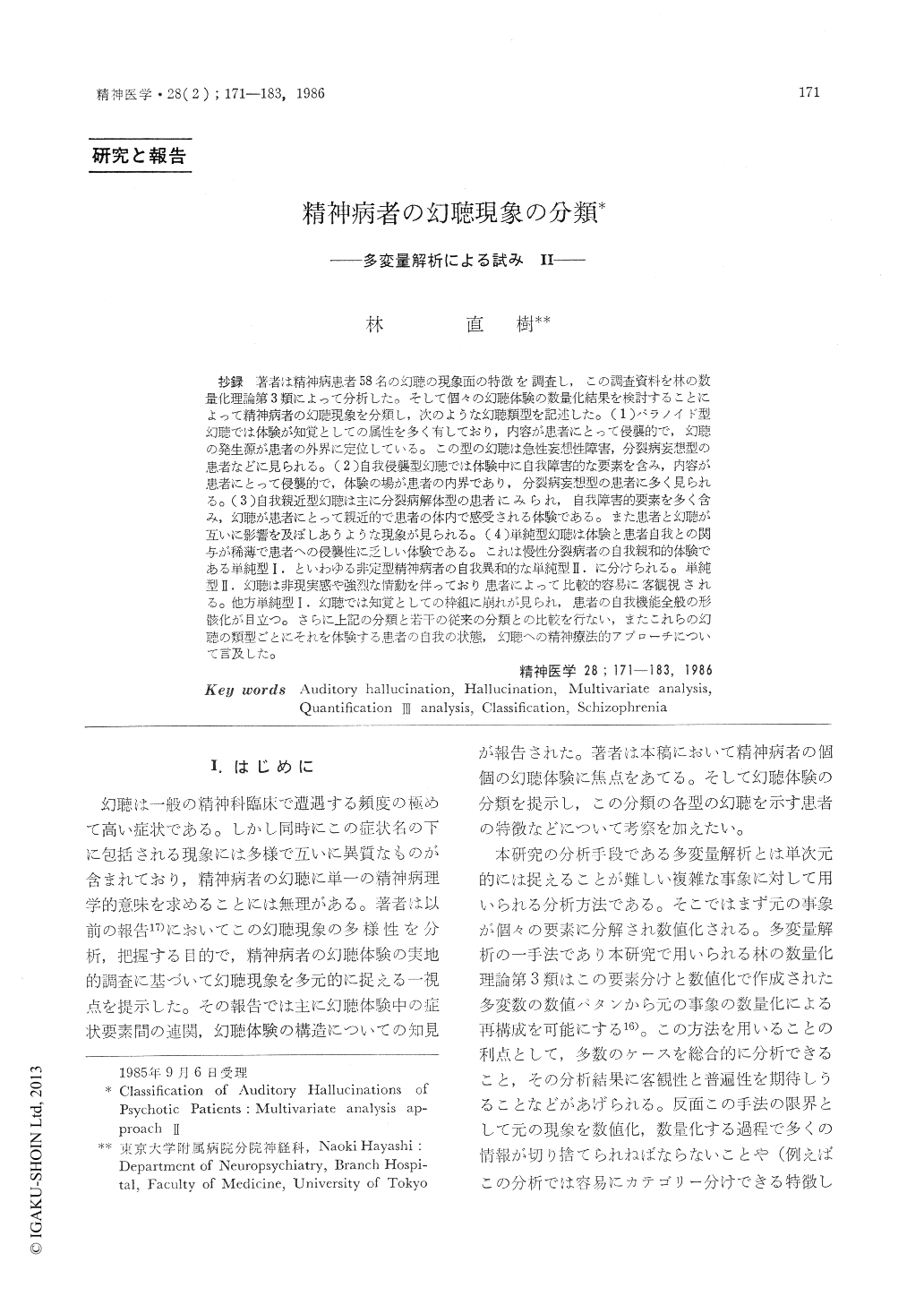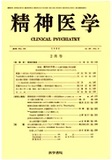Japanese
English
- 有料閲覧
- Abstract 文献概要
- 1ページ目 Look Inside
抄録 著者は精神病患者58名の幻聴の現象面の特徴を調査し,この調査資料を林の数量化理論第3類によって分析した。そして個々の幻聴体験の数量化結果を検討することによって精神病者の幻聴現象を分類し,次のような幻聴類型を記述した。(1)パラノイド型幻聴では体験が知覚としての属性を多く有しており,内容が患者にとって侵襲的で,幻聴の発生源が患者の外界に定位している。この型の幻聴は急性妄想性障害,分裂病妄想型の患者などに見られる。(2)自我侵襲型幻聴では体験中に自我障害的な要素を含み,内容が患者にとって侵襲的で,体験の場が患者の内界であり,分裂病妄想型の患者に多く見られる。(3)自我親近型幻聴は主に分裂病解体型の患者にみられ,自我障害的要素を多く含み,幻聴が患者にとって親近的で患者の体内で感受される体験である。また患者と幻聴が互いに影響を及ぼしあうような現象が見られる。(4)単純型幻聴は体験と患者自我との関与が稀薄で患者への侵襲性に乏しい体験である。これは慢性分裂病者の自我親和的体験である単純型Ⅰ.といわゆる非定型精神病者の自我異和的な単純型Ⅱ.に分けられる。単純型Ⅱ.幻聴は非現実感や強烈な情動を伴っており患者によって比較的容易に客観視される。他方単純型Ⅰ.幻聴では知覚としての枠組に崩れが見られ,患者の自我機能全般の形骸化が目立つ。さらに上記の分類と若干の従来の分類との比較を行ない,またこれらの幻聴の類型ごとにそれを体験する患者の自我の状態,幻聴への精神療法的アプローチについて言及した。
In this report we present the classification of auditory hallucinations from the standpoint of their phenomenology while in the former report we focused on the interrelation of the components and features of auditory hallucinations and the inner structure of the phenomena. For these purposes we investigated in a semistructured setting fifty-eight psychotics (male:48, female;10), who spoke out the experience consistent to our definition of auditory hallucinations, were judged clinically to be endurable to the investigation, and gave the informed consent to participate in this study. The items inquired in the interviews are contents and features of auditory hallucinations, the nature of the origins from which, patients supposed, hallucinations were emanating, and the subjects' emotions and thoughts during the experience. To analyse the data obtained in the interviews we have utilized "Quantification III analysis", which was devised as a multivariate analysis for quantification of categorized data.
According to the quantified data we classify auditory hallucinations find and out four types. (see Fig 1,2,3), and these four types are described and characterized as follows.
Paranoid type: The experiences of this type are "heard" with ears from outside as derogatory and persecutory voices conversing with one another about the patients. Most of perception attributes are intact. These auditory hallucinations are revealed mainly by patients with schizophrenia, paranoid type, and acute paranoid disorder.
Ego disturbing type: This type of the auditory hallucinations accompanies attributes of ego disturbance symptoms (e.g. patients complaint "Voices are controlling and blocking my thought " " Voices must know everything about me"). In the phenomena of this type it is reported that hallucinatory voices are directly speaking to patients, and are percepted within the patients' body. They are imperative, agonizing and derogatory to patients, and are complained mainly by patients with schizophrenia, paranoid type.
Ego familiar type: This type is characterized by its ego familiar nature, as well as by its accompanying ego disturbance features. They seem so deeply ingrained in patients' ego that voices contain helpful contents to patients, converse with patients, and can sometimes be ceased and started by pateints' own will, that is to say, hallucinatory voices and patients seem to affect each other in a reciprocal manner. They are percepted within the patients' bodies, and are directly speaking to patients. Most of patients with schizophrenia, disorganized type report this type of auditory hallucinations.
Simple type: This type is not so invasive to patients as three types described above, and doesn't accompany prominent ego disturbance features. We postulate two subtypes in Simple type auditory hallucinations because we make out that patients experiencing these are to be clinically divided into two groups. One is reported by patients with schizophrenia, residual type and disorganized type, and is named Simple type I. The other, Simple type II., is experienced typically in so-called oneiroid states by patients with schizophrenia, undifferenciated type and schizophreniform psychosis.
As to each of the hallucination types we further discuss the characteristics in personal relations of the patients, and the psychotherapeutic approaches pertinent to them.

Copyright © 1986, Igaku-Shoin Ltd. All rights reserved.


